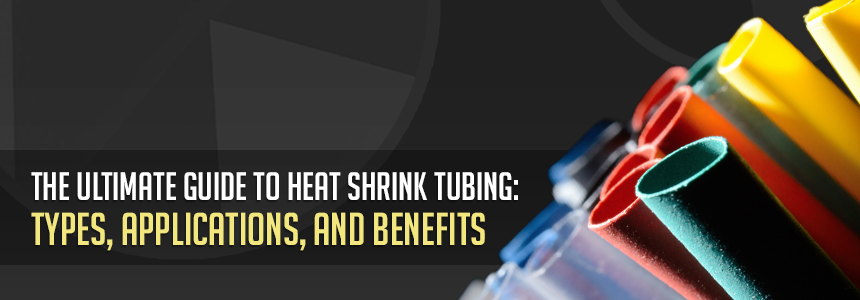The Ultimate Guide to Heat Shrink Tubing: Types, Applications, and Benefits

The Ultimate Guide to Heat Shrink Tubing: Types, Applications, and Benefits
From tube slides to sewer pipes hollow plastic tunnels are as familiar to our daily lives as they are functional. Don't let the gigantic visuals fool you though. The truth is that somewhere every day there's a tiny, little plastic tube you can't even see doing something groundbreaking or breathtaking.
Heat shrink tubing does it all. Shrink wrap tubing does too.
Its versatility, flexibility, and durability give advantages to industries that feed, fuel, fly, finance, fix, and finesse our daily activities. Home organization, mechanical engineering, medical marvels, and more happen because these little plastic tubes are innovative, irreplaceable, and practically indestructible.
A Quick Look at Categories and Considerations
Heat shrink tube offers so much to the world around us. Where and how it goes to work depends on its precise design and molecular composition.
No matter what type, application, or benefits you need from heatshrink, the easiest way to categorize and understand it is by heat resistance categories.
Heat Resistance Categories
The most important consideration for heat shrink tubing is how much heat it needs to activate and how much heat it can withstand.
Spike temperature is the highest threshold in degrees Celsius a heat shrink tube can handle without degrading or failing. It has to hit this melting point briefly to initiate its shrinking process.
Continuous use temperature is degrees Celsius that heat shrink tubing can be exposed to for extended durations. Choosing the best material for your heat shrink needs will depend on how hot its environment will be.
There are 3 main operating temperature categories for heat shrink tubes.
- Standard Temperature 105-135 C
- Low Temperature 80 C
- High Temperature 150+ C
Other Considerations
Knowing where your heat shrink tubing will be used is the best way to understand and buy heat shrink. Extension cord repairs and burning jet fuel are two very different jobs. Here are a few more considerations to help you decide how to pick the heat shrink to suit your needs.
- Flexibility
- Fire resistance
- Voltage
- Chemical exposure
- UV exposure
- Water exposure
Each different type of heat shrink tube comes with its own special considerations. The wide range of applications for heat shrink tubes is truly worth marveling over.
What heat shrink tube is used for and where heat shink is used to revolutionize daily life just might surprise you.
Standard Temperature Heat Shrink at Home
At 105 to 135 C, this heat resistance category belongs to your general, every day at home use. Almost all of your household, garage, and DIY applications will be found here.
These heat shrink tubes can be melted at home with a heat gun or butane torch in the comfort and safety of your home. Our most popular products are 2:1 polyolefin and dual wall (adhesive lined) heat shrink.
The Powers of Polyolefin
Polyolefin is the most common material for heat shrink. It's a special kind of thermoplastic made from hydrogen and carbon bonds. It is durable, non-toxic, and non-corrosive.
Polyolefin has the broadest range of continuous use temperatures from -55 to 135 C. It shrinks quickly, remains flexible, and comes in more colors than any other type of heat shrink.
The military, aerospace, TV, computer, and railway worlds are huge consumers of polyolefin heat shrink tubing. The rainbow-hued cacophony of color-coded wires behind your plasma screen and inside your laptop is thanks to the powers of polyolefin. Offering simple, colorful ways to organize, identify, and label your home wires and cables, 2:1 polyolefin can help you bundle or wrap that.
Polyolefin Pros
- Inexpensive
- Readily available in multiple colors
- High gloss finish and superb clarity
- Perfect for personalized printing
- Versatile, strong, and easy to use
Polyolefin Cons
- Low tolerance to UV light
- Not chemically resistant to gasoline, diesel fuels, or mineral oil.
- Inferior for near water applications
2:1 polyolefin heat shrink tubing brings bright colors and affordable protection to general-purpose home and automotive use. It's versatile, easy to use, our best seller, and a customer favorite.
Heat shrink tube applications at home are pretty, popular, and practical, but your daily lives encounter more heat shrink than you think.
Low Temperature, Ultra-thin Wall Heat Shrink in the Medical World
With a melting point around 80 C, low-temperature heat shrink isn't just ultra-thin, it's ultrasmooth, incredibly hard, easy to print on, and wicked useful.
Typically made from polyolefin or fluoropolymer, ultra-thin wall heat shrink tubing is 10 to 100 times thinner than other heat shrink tubes and up to 10 times stronger.
These benefits are game changers in the healthcare industry. With a need for less-invasive medical procedures and instruments that are smaller, thinner, and well-marked ultra-thin wall heat shrink is the clear winner.
On Your Marks
Printing on ultra-thin wall heat shrink tubing allows the medical industry to accurately label, mark, measure, and improve production processes while reducing diameters and product profile sizes. Depth marks and labels printed on clear heat shrink tubing are easy to position on top of catheters or bottles without interfering with form or function or requiring expensive and complex devices to be sent out for specialization.
Get Ultra-thin Wall and Go
Ultra-thin wall heat shrink tubing offers advantages to medical devices like:
- Variable-stiffness catheters
- Endoscopic and laparoscopic procedures
- Cauterization instruments
- Tube joining
- Catheter tip formation
- Masking for coatings
- Micro hose clamps
- Bundling components
- Encapsulating and protecting coverings
- Electrical insulation
Ultra-thin wall heat shrink tubing offers one of the highest dielectric strengths on the market. This effective electrical insulation material is perfect for covering needles to protect the skin during electrical stimulation and insulating electrosurgical devices and other medical wiring components.
Medical designers and manufacturers looking for ways to make devices smaller and thinner while increasing features and decreasing bulk rely on the biocompatibility, high flex fatigue, and intense tensile strength of ultra-thin wall heat shrink tubing.
High-Temperature Heat Shrink in All its Glory
Withstanding continuous use temperatures above 135 C and reaching up to 240 C, high-temperature heat shrink tubing is made from high-performing plastics called fluoropolymers.
While the healthcare industry certainly capitalizes upon the marvels that fluoropolymers bring to heat shrink tubing, it's not the only one. Aerospace, technology, and engineering industries all rely on the rugged performance of high-temperature heat shrink tubes.
Fantastic Feats of Fluoropolymers
Fluoropolymers are a unique combination of carbon and fluorine bonds. They are known for their durability, heat and chemical resistance, and ability to perform under the toughest conditions and highest heat. They're vital in the manufacturing and use of TVs, laptops, telecommunications, chemical/petrol processing, advanced transportation, instantaneous commerce, and sharing and storing of data.
Fluoropolymers create sustainable solutions, energy efficiency, alternative energy, product longevity, and improved safety and processing.
Here are a few more standout mentions for fluoropolymer heat shrink tubes.
- High resistance to solvents, acids, and bases
- Extreme weatherability
- Excellent electric insulators
- Unmatched chemical and temperature resistance
- Corrosion protection
- Flame retardant coverings
- Petrochemical transfer
- Internal sheathing and connector sleeves
- Reduced friction and non-stick properties
- Critical use in fuel cells and lithium-ion battery technology
- Lightweight, fuel efficient, and leak prevention
- Environmentally and ecologically advantageous
Heat shrink tubes made from thermoplastic fluoropolymers are durable, affordable, and recyclable. The most popular and commercially used fluoropolymers heat shrink tubes are:
- Fluororubber (FKM aka Viton)
- Polyvinylidene fluoride (PVDF aka Kynar)
- Polytetrafluoroethylene (PTFE aka Teflon)
If you need heat shrink tubing that retains its structural capabilities between 150 to 250 C, check out these top 3 performing fluoropolymers that can handle their heat.
Viton Heat Shrink
This fluoroelastomer rubber is a thermoset plastic made of carbon and hydrogen bonds. It's strong, flexible, and has superb mechanical properties.
Developed in 1948 for World War II airplanes, Viton performs well in environments with aggressive gas and oil such as heavy-duty machinery and chemical processing.
Viton Pros
- Broad range of continuous-use temperatures
- Excellent strain relief and strength under pressure
- Oxidation resistance
- Meets FDA and sanitation standards
Viton Cons
- Less chemical resistance to molten gasses, acetones, and organic acids
- Poor performance against steam and water
- Limited supply chain
If you need high-tensile, flexible, and thermal resistant heat shrink tubing try our full stock of Viton heat shrink.
Kynar Heat Shrink
This lightweight, low-density fluoropolymer produces excellent thermal conductivity with high chemical and corrosion resistance.
Kynar is used in lithium-ion batteries, water purity and filtration, and the production of electric vehicles and medical and defense equipment.
Kynar Pros
- Higher elasticity and less rigidity
- Available in more colors
- Easier to produce
- UV and radiation resistant
- Excellent water and steam resistance
- High mechanical strength
Kynar Cons
- High demand
- Subject to price fluctuation
- Adds surface roughness
- Softer than other types
Due to the high demand for electric vehicles, Kynar is sometimes difficult to find. If you need heat shrink tubing with superior performance through high water, extreme weather, and UV exposure try our Kynar heat shrink tubes.
PTFE (Teflon) Heat Shrink
PTFE or polytetrafluoroethylene has the widest-range of continuous use temperatures. It's also very temperature stable and performs consistently across high-wear and high-temperature applications.
Accidentally discovered in 1938, PTFE is one of the most popular and commercialized types of heat shrink tubing. These durable little tubes are useful in fire-critical applications, heating elements, jet engines, aircraft fittings, UV lamps, and more.
PTFE Pros
- Improved impact strength
- Smooth and hard
- Excellent in caustic and high-pressure environments
- High electrical resistance
- Resistant to almost all chemicals, solvents, weather, UV light, and corrosion
PTFE Cons
- More brittle than other fluoropolymers
- Poor radiation resistance
- Inelasticity
- Supply chain issues after its US manufacturer left the market
PTFE's ability to withstand even the harshest environments make it one of the best performing heat shrink materials on the market. Don't let supply chain shortages slow you down. Explore and experience all the extraordinary properties of our PTFE heat shrink.
What's Your Ultimate Heat Shrink Tube?
We may see hollow, plastic hamster tunnels and bendy straws more than we recognize the places where the heat shrink tubing changes our lives, but there's no doubt that every type of heat shrink tube adds something special to our day-to-day lives.
From minimally-invasive medical innovations to perfectly-printed solutions at home or the hospital to mechanical engineering for transportation, technology, and telecommunications, heat shrink tubing does it all.
Whether you need a general-use polyolefin or a chemically complex fluoropolymer, there's a masterfully designed type of heat shrink tubing just waiting for you to choose.














